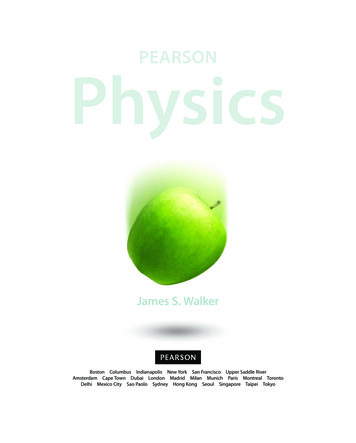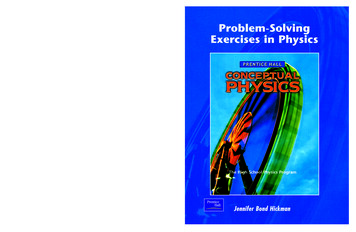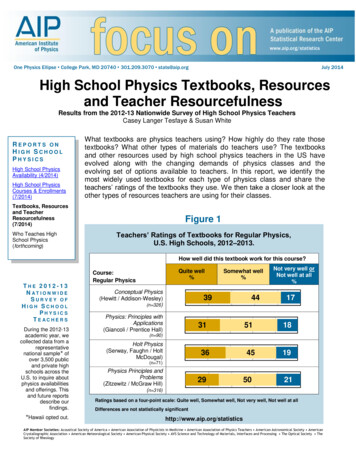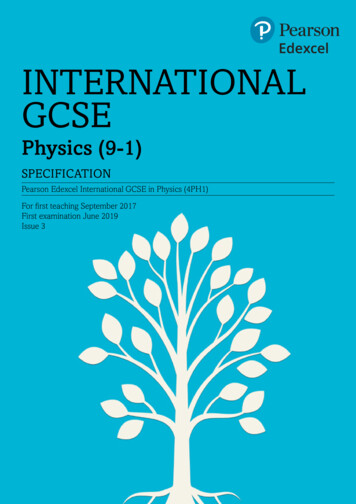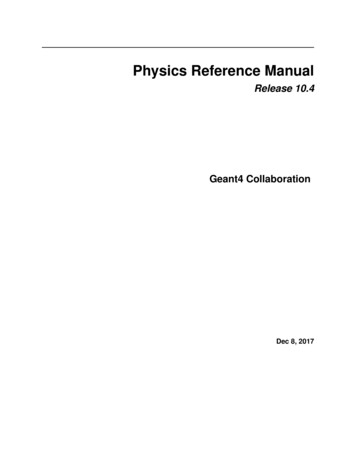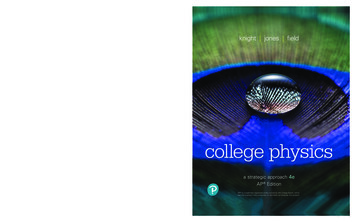
Transcription
College Physics: A Strategic Approach, 4th edition, expandsits focus from how mixed majors students learn physics towhy these students learn physics. By applying the bestresults from educational research and MasteringTM Physicsmetadata, the authors present basic physics at work inreal-world examples to engage students and help themmake connections between other fields including biologicalsciences, architecture, and natural resources.engage today’sstudentswith real-worldphysics NEW! What the Physics? Videos bring new, relatablecontent that engages students in the concept and promotescuriosity for natural phenomena. NEW! Direct Measurement Videos are short videosthat show real situations of physical phenomena. NEW! The Physics Primer relies on videos, hints, andfeedback to refresh students’ math skills in the context ofphysics and prepare them for success in the course. NEW! Qualitative and Quantitative Prelecture Videosare assignable, interactive videos that complement theexisting Conceptual Prelecture Videos. Dynamic Study Modules (DSMs) help students studyeffectively on their own by continuously assessing theiractivity and performance in real time and adapting totheir level of understanding. Pearson eText, optimized for mobile, seamlesslyintegrates videos and other rich media with the text andgives students access to their textbook anytime, anywhere.Please visit us at www.PearsonSchool.com/Advanced formore information. To order any of our products, contactour customer service department at (800) 848-9500.www.PearsonSchool.com/AdvancedISBN-13: 978-0-13-477921-8ISBN-10:0-13-477921-59 0 0 0 09KNIG9218 04 cvrmech.indd 1780134 779218a strategic approach 4eAP EditionFind the following enhanced media in Mastering Physics,the most effective and widely used online homework, tutorial,and assessment system for the sciences, at pearson.com/mastering/physics.college physicsExtensive new media and an interactive eText pique studentinterest while challenging misconceptions and fosteringcritical thinking. New examples, explanations, and problemsuse real data from research to show physics at work inrelatable situations, and help students see that physics is thescience underlying everything around them. College Physics:A Strategic Approach, 4th edition, encourages today’s studentsto understand the big picture, gain crucial problem-solvingskills and confidence, and better prepare for class.knight–jones–fieldknight jones fieldcollege physicsa strategic approach 4eAP EditionAP is a trademark registered and/or owned by the College Board, whichwas not involved in the production of, and does not endorse, this product.14/10/17 1:52 PM
ENGAGE today’s studentsFor the fourth editionof College Physics: AStrategic Approach,we expand our focusfrom HOW studentslearn physics toWHY students studyphysics. We now makeconnections to biologyand other sciencesthroughout the textto keep studentsengaged, presentingcontent that isrelevant to today’sstudents. This newedition is one of thebest college physicsbook on the marketfor non-physicsmajors.A01 KNIG9218 04 AP WT.indd 108/11/17 10:14 AM
More connections to life scienceBuild students’ problem-solving skills in a context they care about while usingreal-life data and examples to keep their interest piqued.13.7 The Circulatory SystemThe Arteries and CapillariesIn the human body, blood pumped from the heart to the body starts its journey in asingle large artery, the aorta. The flow then branches into smaller blood vessels, thelarge arteries that feed the head, the trunk, and the limbs. These branch into stillsmaller arteries, which then branch into a network of much smaller arterioles, whichbranch further into the capillaries. FIGURE 13.37 shows a schematic outline of the circulation, with average values for the diameters of the individual vessels, the totalcross-section area of all of each type of vessel considered together, and the pressurein these vessels, assuming that the person is lying down so that there is no pressurechange due to differences in elevation.NEW! Topics of interest tolife science students, suchas the nature of the dragforce at different scales andqualitative and quantitativedescriptions of diffusion,provide current coverage ofrelevant topics based on theevolving consensus in theintroductory physics for the lifesciences community.This preserved section of blood vesselsshows the tremendous increase in numberand in total area as blood vessels branchfrom large arteries to arterioles. One largeartery gives rise to thousands of smallervessels.8.5 Forces and Torques in the BodyNEW! Material stressingthe application of physicsto life sciences includesstructural color in animals andplants, the electric sense ofdifferent animals, the circulatorysystem (13.7) and on forces andtorques in the body (8.5).A01 KNIG9218 04 AP WT.indd 2Let’s take your foot as the FIGURE 8.27 Forces on the footobject of interest. When you stand when standing on tiptoe.on tiptoe, your foot pivots aboutAchilles tendonyour ankle. As shown in FIGURE 8.27,Ankle pivotthe forces on one foot are anupward force on your toes fromthe floor, a downward force onyour ankle from the lower legbone, and an upward force on theheel of your foot from your15 cmAchilles tendon. Suppose a 61 kg20 cmwoman stands on one foot, ontiptoe, with the sole of her footmaking a 25 angle with the floor; the distances are as shown inFigure 8.27. What is the magnitude of the tension force in thetendon? By what fraction does this force exceed the woman’sweight? What is the magnitude of the force in the ankle joint?08/11/17 10:14 AM
create relevance to students’ livesEXAMPLE 2.16Finding the height of a leapA springbok is an antelope foundin southern Africa that gets itsname from its remarkable jumpingability. When a springbok is startled, it will leap straight up into theair—a maneuver called a “pronk.”A particular springbok goes into acrouch to perform a pronk. It then extends its legs forcefully,accelerating at 35 m/s2 for 0.70 m as its legs straighten. Legsfully extended, it leaves the ground and rises into the air.NEW! STRATEGIZE step in Examplesshows students the “big picture” viewbefore delving into the details. Classroomtesting of this addition has shown it tobe popular with students and effective inteaching problem-solving skills.a. At what speed does the springbok leave the ground?b. How high does it go?This is a two-part problem. In the first phase of itsmotion, the springbok accelerates upward, reaching some maximum speed just as it leaves the ground. As soon as it does so, thespringbok is subject to only the force of gravity, so it is in freefall. For both phases, we will use the constant-acceleration equations from Synthesis 2.1.STRATEGIZE8. A hippo’s body is 4.0 m long with front and rear feetlocated as in Figure P8.8. The hippo carries 60% of itsweight on its front feet. How far from its tail is the hippo’scenter of gravity?NEW! End-of-chapter problemsets now include real-life data andexamples, helping students buildtransferable skills for their futurecourses and careers.0.5 m1.8 m1.7 mFIGURE P8.8NEW! Learning Objectives, keyed to relevant end-of-chapter problems,help students check their understanding and guide them in choosingappropriate problems to optimize their study time.Learning ObjectivesAfter studying this chapter, you should be able to: Use motion diagrams to interpret motion. Conceptual Calculate the acceleration of an object. Problems 2.25, 2.27,2.32, 2.33, 2.72 Use and interpret motion graphs. Conceptual Questions 2.5,2.13; Problems 2.4, 2.18, 2.19, 2.22, 2.62 Determine and interpret the sign of acceleration. ConceptualQuestions 2.2, 2.8; Problem 2.50 Calculate the velocity of an object. Conceptual Question 2.9;Problems 2.8, 2.15, 2.57 Solve problems about an object in uniform motion.Use the problem-solving approach to solve problems of motionwith constant acceleration and free fall. Problems 2.36, 2.40,2.41, 2.47, 2.52, 2.75A01 KNIG9218 04 AP WT.indd 308/11/17 10:14 AM
Prepare students for engagementNEW! What the Physics? Videos bringrelatable content to engage studentswith what they are learning and promotecuriosity for natural phenomena. These shortvideos present visually stimulating physicalphenomena, pause throughout to addressmisconceptions, and ask conceptual questionsabout the physics at hand. Quantitativequestions follow some of the videos andwill be assignable in MasteringTM Physics andembedded in the eText.Prelecture Videos, presented by co-author BrianJones, expand on the Chapter Previews, givingcontext, examples, and a chance for students topractice the concepts they are studying via shortmultiple-choice questions. NEW! Qualitative andQuantitative prelecture videos now availablewith assessment as well!NEW! eText, optimized formobile, seamlessly integrates videos andother rich media with the text and givesstudents access to their textbook anytime,anywhere. eText is available with MasteringPhysics when packaged with new books, or asan upgrade students can purchase online.A01 KNIG9218 04 AP WT.indd 408/11/17 10:15 AM
in lecture with interactive mediaNEW! The Physics Primerrelies on videos, hints, andfeedback to refresh students’math skills in the context ofphysics and prepare them forsuccess in the course. Thesetutorials can be assignedbefore the course begins aswell as throughout the course.They ensure students practiceand maintain their mathskills, while tying togethermathematical operations andphysics analysis.Dynamic Study Modules (DSMs) help studentsstudy effectively on their own by continuouslyassessing their activity and performance in realtime and adapting to their level of understanding.The content focuses on definitions, units, and thekey relationships for topics across all of mechanicsand electricity and magnetism.A01 KNIG9218 04 AP WT.indd 508/11/17 10:15 AM
Enhance students’ understandingNEW! Direct MeasurementVideos are short videos thatshow real situations of physicalphenomena. Grids, rulers,and frame counters appear asoverlays, helping students tomake precise measurementsof quantities such as positionand time. Students then applythese quantities along withphysics concepts to solveproblems and answer questionsabout the motion of theobjects in the video.Learning Catalytics helps generateclass discussion, customize lectures, andpromote peer-to-peer learning withreal-time analytics. Learning Catalyticsacts as a student response tool that usesstudents’ smartphones, tablets, or laptopsto engage them in more interactive tasksand thinking: NEW! Upload a full PowerPoint deckfor easy creation of slide questions. M onitor responses to find out whereyour students are struggling. R ely on real-time data to adjust yourteaching strategy. A utomatically group students fordiscussion, teamwork, and peer-to-peerlearning.A01 KNIG9218 04 AP WT.indd 608/11/17 10:15 AM
Supplements further enhancethe learning experienceFor the StudentThe following resources are available for purchase:10-8CHAPTER10 . Energy and Work10.6 Potential Energy17. Below we see a 1 kg object that is initially 1 m above the ground and rises to a height of 2 m.Anjay and Brittany each measure its position but use a different coordinate system to do so.Fill in the table to show the initial and final gravitational potential energies and DU asmeasured by Anjay and Brittany.AnjayBrittanyEnds hereUiStudent Workbook (9780134609898)A key component of College Physics: A Strategic Approach is theaccompanying Student Workbook. The workbook bridges the gap betweentextbook and homework problems by providing students the opportunity tolearn and practice skills prior to using those skills in quantitative end-of-chapterproblems, much as a musician practices technique separately from performancepieces. The workbook exercises, which are keyed to each section of the textbook,focus on developing specific skills, ranging from identifying forces and drawingfree-body diagrams to interpreting field diagrams.2mUfDUAnjay0Starts hereBrittany018. Three balls of equal mass are fired simultaneously with equal speedsfrom the same height above the ground. Ball 1 is fired straight up,ball 2 is fired straight down, and ball 3 is fired horizontally. Rank inorder, from largest to smallest, their speeds v1, v2, and v3 as they hitthe ground.Ball 1Ball 3Ball 2Order:Explanation:19. Below are shown three frictionless tracks. Ablock is released from rest at the position shownon the left. To which point does the block make it on the right before reversing direction andsliding back? Point B is the same height as the starting position.AABMakes it toABCBCMakes it toCMakes it toStudent Solution Manuals(Chs. 1–16; 9780134704197) (Chs. 17–30; 9780134724799)These solutions manuals contain detailed solutions to all of the odd-numberedend-of-chapter problems from the textbook.For the TeacherNEW! Ready-to-Go Teaching Modules(Online only) Created for and by instructors, make useof teaching tools for before, during, and after class,including new ideas for in-class activities. The modulesincorporate the best that the text, Mastering Physics,and Learning CatalyticsTM have to offer and guideinstructors through using these resources in the mosteffective way. The modules can be accessed through theInstructor Resources Area of Mastering Physics and aspre-built, customizable assignments.Instructor’s Solutions Manual (Online Only)This comprehensive solutions manual contains completesolutions to all end-of-chapter questions and problems.TestGen Test Bank (Online Only) The Test Bankcontains more than 2,000 high-quality problems, with a range of multiple-choice, true/false,short answer, and regular homework-type questions. Test files are provided in both TestGenand Word formats.Instructor’s Resource Materials (Online Only) All art, photos, and tables from thebook are available in JPEG format and as modifiable PowerPointsTM. In addition, instructors canaccess lecture outlines as well as “clicker” questions in PowerPoint format, editable content forkey features, all the instructor’s resources listed above, and solutions to the Student Workbook.Materials are accessible to download from the Instructor Resource area of Mastering Physics.A01 KNIG9218 04 AP WT.indd 708/11/17 10:15 AM
Mastering Physics AccessMastering PhysicsUpon textbook purchase, students and teachers are grantedaccess to Mastering Physics with Pearson eText. High schoolteachers can obtain preview or adoption access to MasteringPhysics in one of the following ways:Preview Access Teachers can request preview access online by visiting www.PearsonSchool.com/Access Request. Select Science, choose Initial Access, and complete the form underOption 2. Preview Access information will be sent to the teacher via e-mail.Adoption Access With the purchase of this program, a Pearson Adoption Access Card withInstructor Manual will be delivered with your textbook purchase. (ISBN: 978-0-13354087-1) Ask your sales representative for a Pearson Adoption Access Card with InstructorManual. (ISBN: 978-0-13-354087-1)OR Visit PearsonSchool.com/Access Request, select Science, choose Initial Access, andcomplete the form under Option 3—MyLab/Mastering Class Adoption Access.Teacher and Student access information will be sent to the teacher via e-mail.Students, ask your teacher for access.Pearson reserves the right to change and/or update technology platforms, including possibleedition updates to customers during the term of access. This will allow Pearson to continue todeliver the most up-to-date content and technology to customers. Customer will be notified ofany change prior to the beginning of the new school year.A01 KNIG9218 04 AP WT.indd 808/11/17 10:16 AM
college physicsa strategic approach 4eAP Editionrandall d. knight brian jones stuart fieldCalifornia Polytechnic State University,San Luis ObispoColorado State UniversityColorado State University330 Hudson Street, NY NY 10013A01 KNIG9218 04 AP FM ppi-xxv.indd 108/11/17 9:41 AM
Editor in Chief, Director Physical Science Courseware Portfolio: Jeanne ZaleskyEditor, Physics Courseware Portfolio Analyst:Darien EstesSenior Content Producer:Martha SteeleDavid HoogewerffSenior Content Developer:Managing Producer:Kristen FlathmanJennifer HartCourseware Director, Content Development:Senior Analyst, Content Development, Science:Suzanne OlivierCourseware Editorial Assistant:Kristen StephensDustin HennesseyRich Media Content Producer:Full-Service Vendor: Nesbitt Graphics/Cenveo Publisher ServicesCopyeditor:Carol ReitzCompositor: Nesbitt Graphics/Cenveo Publisher ServicesArt and Design Director:Mark Ong/Side By Side StudiosInterior/Cover Designer:tani hasegawaRights & Permissions Project Manager:Katrina MohnRights & Permissions Management:Ben FerriniDena Digilio BetzPhoto Researcher:Manufacturing Buyer: Stacey J. Weinberger/LSC CommunicationsProduct Marketing Manager, Physical Sciences:Elizabeth BellMirageC/GettyCover Photo Credit:Copyright 2019, 2017, 2015, 2010, 2007 Pearson Education, Inc. All Rights Reserved. Printedin the United States of America. This publication is protected by copyright, and permission shouldbe obtained from the publisher prior to any prohibited reproduction, storage in a retrieval system,or transmission in any form or by any means, electronic, mechanical, photocopying, recording, orotherwise. For information regarding permissions, request forms and the appropriate contacts withinthe Pearson Education Global Rights & Permissions department, please visit www.pearsoned.com/permissions/.AP is a trademark registered and/or owned by the College Board, which was not involved in the production of, and does not endorse, this product.Acknowledgements of third party content appear on pages C1–C4, which constitutes an extension ofthis copyright page.PEARSON, ALWAYS LEARNING and MasteringTM Physics are exclusive trademarks in the U.S.and/or other countries owned by Pearson Education, Inc. or its affiliates.Unless otherwise indicated herein, any third-party trademarks that may appear in this work are theproperty of their respective owners and any references to third-party trademarks, logos, or other tradedress are for demonstrative or descriptive purposes only. Such references are not intended to implyany sponsorship, endorsement, authorization, or promotion of Pearson’s products by the ownersof such marks, or any relationship between the owner and Pearson Education, Inc. or its affiliates,authors, licensees, or distributors.Library of Congress Cataloging in Publication Control Number: 2017044155www.PearsonSchool.com/AdvancedISBN 10: 0-13-477921-5 (High School Binding)ISBN 13: 978-0-13-477921-8 (High School Binding)1 19A01 KNIG9218 04 AP FM ppi-xxv.indd 208/11/17 9:41 AM
About the AuthorsRandy Knight taught introductory physics for 32 years at Ohio State Universityand California Polytechnic State University, where he is Professor Emeritus of Physics. Professor Knight received a Ph.D. in physics from the University of California, Berkeley and was a post-doctoral fellow at the Harvard-Smithsonian Center forAstrophysics before joining the faculty at Ohio State University. It was at Ohio Statethat he began to learn about the research in physics education that, many years later,led to Five Easy Lessons: Strategies for Successful Physics Teaching and this book,as well as Physics for Scientists and Engineers: A Strategic Approach. ProfessorKnight’s research interests are in the fields of laser spectroscopy and environmentalscience. When he’s not in front of a computer, you can find Randy hiking, sea kayaking, playing the piano, or spending time with his wife Sally and their five cats.Brian Jones has won several teaching awards at Colorado State University duringhis 30 years teaching in the Department of Physics. His teaching focus in recent yearshas been the College Physics class, including writing problems for the MCAT examand helping students review for this test. In 2011, Brian was awarded the Robert A.Millikan Medal of the American Association of Physics Teachers for his work asdirector of the Little Shop of Physics, a hands-on science outreach program. He isactively exploring the effectiveness of methods of informal science education andhow to extend these lessons to the college classroom. Brian has been invited to giveworkshops on techniques of science instruction throughout the United States and inBelize, Chile, Ethiopia, Azerbaijan, Mexico, Slovenia, Norway, and Namibia. Brianand his wife Carol have dozens of fruit trees and bushes in their yard, including anapple tree that was propagated from a tree in Isaac Newton’s garden.Stuart Field has been interested in science and technology his whole life. While inschool he built telescopes, electronic circuits, and computers. After attending Stanford University, he earned a Ph.D. at the University of Chicago, where he studiedthe properties of materials at ultralow temperatures. After completing a postdoctoralposition at the Massachusetts Institute of Technology, he held a faculty position atthe University of Michigan. Currently at Colorado State University, Stuart teachesa variety of physics courses, including algebra-based introductory physics, and wasan early and enthusiastic adopter of Knight’s Physics for Scientists and Engineers.Stuart maintains an active research program in the area of superconductivity. Stuartenjoys Colorado’s great outdoors, where he is an avid mountain biker; he also playsin local ice hockey leagues.iiiA01 KNIG9218 04 AP FM ppi-xxv.indd 308/11/17 9:41 AM
Preface to the InstructorIn 2006, we published College Physics: A Strategic Approach, a new algebra-basedphysics textbook for students majoring in the biological and life sciences, architecture, natural resources, and other disciplines. As the first such book built fromthe ground up on research into how students can more effectively learn physics, itquickly gained widespread critical acclaim from professors and students alike. Forthis fourth edition, we have continued to build on the research-proven instructionaltechniques introduced in the first edition while working to make the book more useful for instructors, more relevant to the students who use it, and more connected tothe other subjects they study.ObjectivesOur primary goals in writing College Physics: A Strategic Approach are: To provide students with a textbook that’s a more manageable size, less encyclopedic in its coverage, and better designed for learning.To integrate proven techniques from physics education research into the classroom in a way that accommodates a range of teaching and learning styles.To help students develop both quantitative reasoning skills and solid conceptualunderstanding, with special focus on concepts well documented to cause learningdifficulties.To help students develop problem-solving skills and confidence in a systematicmanner using explicit and consistent tactics and strategies.To motivate students by integrating real-world examples that are relevant to theirmajors—especially from biology, sports, medicine, the animal world—and thatbuild upon their everyday experiences.To utilize proven techniques of visual instruction and design from educationalresearch and cognitive psychology that improve student learning and retentionand address a range of learner styles.A more complete explanation of these goals and the rationale behind them can befound in Randy Knight’s paperback book, Five Easy Lessons: Strategies for Successful Physics Teaching. Available for purchase. (ISBN 978-0-805-38702-5)What’s New to This EditionIn previous editions of the text, we focused on how students learn physics. Eachchapter was built from the ground up to present concepts and problem-solving strategies in an engaging and effective manner. In this edition, we are focusing on why students learn physics. This is a question our students often ask. Why should a biologymajor take physics? A student planning a career in medicine? This book is for a physics course, but it’s a course that will generally be taken by students in other fields.The central goal of this edition is to make the text more relatable to the studentswho will use it, to add examples, explanations, and problems that show physics atwork in contexts the students will find engaging. We’ve considered extensive feedback from scores of instructors and thousands of students as we worked to enhanceand improve the text, figures, and end-of-chapter problems. Instructors need not bespecialists in the life sciences or other fields to appreciate the new material. We’vedone the work to connect physics to other disciplines so that instructors can use thismaterial to engage their students while keeping their focus on the basic physics.ivA01 KNIG9218 04 AP FM ppi-xxv.indd 408/11/17 9:41 AM
Preface to the InstructorvMaking the text more relatable meant making significant changes throughout thebook. These edits aren’t cosmetic add-ons; they reflect a thorough reworking of eachchapter. Changes include: Guided by an evolving consensus in the Introductory Physics for the Life Sciencescommunity, we have included new sections on the nature of the drag force at different scales, qualitative and quantitative descriptions of diffusion, and other topics of interest to life science students.We have added a great deal of new material that stresses the application of physics to life science topics. For example, we have expanded our treatment of visionand vision correction, included new material on structural color in animals andplants and the electric sense of different animals, and added new sections on thecirculatory system and on forces and torques in the body.We have made new connections between physics topics and other courses thatstudents are likely to take. For example, a new section connects the concept of theconservation of energy to topics from chemistry, including ionization energy andthe role of catalysts in reactions. We have continued this approach when we introduced the concept of electric potential energy.Hundreds of new end-of-chapter questions and problems show physics at workin realistic, interesting situations. We have replaced problems that are artificialand abstract with problems that use real data from research in life science fields,problems that show the physics behind modern technologies, and problems thatuse physics to explore everyday phenomena. We have used the wealth of datafrom MasteringTM Physics to make sure that we have problems of a wide range ofdifficulties for each topic and problem-solving approach. A rigorous blind-solvingand accuracy cross-checking process has been used to check all new problems tobe sure that they are clearly worded and correct in all details, that they are accompanied by carefully worked out solutions.New examples throughout the book use the concepts of the chapters to explorerealistic situations of interest to the students—from how bees use electric fields tolocate promising flowers to how a study of force and torque in the jaw explainswhy dogs have long snouts and cats don’t.We have changed the photos and captions at the starts of the chapters and partsof the text to better interest and engage students. The questions that are raised atthe starts of the chapters aren’t rhetorical; they are questions that will be answeredin the flow of the chapter.We have also made a number of changes to make the text an even more effectivetool for students: A new STRATEGIZE step in examples shows students the “big picture” viewbefore we delve into the details. Classroom testing of this addition has shown it tobe quite popular with students, and quite effective in teaching problem-solvingskills.Key Concept figures encourage students to actively engage with key or complexfigures by asking them to reason with a related STOP TO THINK question.Additional STOP TO THINK questions provide students with more crucialpractice and concept checks as they go through the chapters. The solutions tothese questions have been moved to a more prominent location.We now provide Learning Objectives keyed to relevant end-of-chapter problemsto help students check their understanding and guide them in choosing appropriate problems to optimize their study time.Streamlined text and figures tighten and focus the presentation to more closelymatch student needs. We’ve scrutinized every figure, caption, discussion, andphoto in order to enhance their clarity and focus their role.Increased emphasis on critical thinking, modeling, and reasoning, both inworked examples and in end-of-chapter problems, promotes these key skills.These skills are especially important for students who are taking the MCAT exam.A01 KNIG9218 04 AP FM ppi-xxv.indd 508/11/17 9:41 AM
viPreface to the Instructor Expanded use of realistic and real-world data ensures students can make senseof answers that are grounded in the real world. Our examples and problems usereal numbers and real data; they test different types of reasoning using equations,ratios, and graphs.We have made many small changes to the flow of the text throughout, streamlining derivations and discussions, providing more explanation for complex conceptsand situations, and reordering and reorganizing material so that each section andeach chapter have a clearer focus. We have updated our treatment of entropy andthe second law to better match current thinking. We have reordered the presentationof material on motion in two dimensions to be more logical. Every chapter has significant and meaningful changes, making this course especially relevant for today’sstudents.We know that students increasingly rely on sources of information beyond the text,and instructors are looking for quality resources that prepare students for engagementin lecture. The text will always be the central focus, but we have added additionalmedia elements closely t
physics. We now make connections to biology and other sciences throughout the text to keep students engaged, presenting content that is relevant to today’s students. This new edition is one of the best college physics book on the market for non-physics



